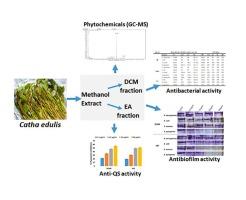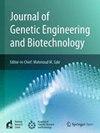Phytochemical screening and inhibitory effects of Catha edulis Forsk extracts on oxidation, growth, biofilm and quorum sensing of selected pathogens
IF 2.8
Q3 Biochemistry, Genetics and Molecular Biology
Journal of Genetic Engineering and Biotechnology
Pub Date : 2025-08-29
DOI:10.1016/j.jgeb.2025.100560
引用次数: 0
Abstract
The treatment of infectious diseases is increasingly challenging due to the emergence and re-emergence of antibiotic-resistant bacteria. Plant-derived natural products are being explored as potential solutions to this global threat. This study investigated the phytochemical composition of Catha edulis and biological properties of its extracts, focusing on their potential as antioxidants and antimicrobials. Gas chromatography/mass spectrometry (GC/MS) of the methanol extract (MeOHE) fractions revealed 11 compounds in dichloromethane fraction (DCMF) and 30 compounds in ethyl acetate fraction (EAF), many of which possess bioactive functions as antioxidants and antimicrobials. Phytol was detected at 60.32 %, not reported before in C. edulis. The antioxidation potential of extracts was assayed by radical scavenging activity (RSA), and the IC50 values ranged from 68.2 to 89.3 µg/mL, respectively indicating good antioxidant potency. In the disc diffusion assay against representative pathogenic bacteria, the extracts exhibited an inhibition order of EAF > DCMF > MeOHE in the 31–75 % range. The minimum inhibitory concentration (MIC) for MeOHE and DCMF were in the 0.5 − >1 mg/mL range, while the minimum bactericidal concentration (MBC) were from 2 to > 2 mg/mL. EAF showed a MIC and MBC in the 0.5–––1 mg/mL and 1–––2 mg/mL range, suggesting better inhibition potential. The tolerance test values showed bactericidal activity against all the tested bacteria. The minimum biofilm inhibitory concentration (MBIC) values of DCMF were 250 to > 500 µg/mL, while EAF ranged from 125 to 500 µg/mL, indicating effective inhibition of biofilm formation. The anti-quorum sensing (anti-QS) activity of DCMF and EAF on P. aeruginosa showed 55.8 % and 51.4 % inhibition of pyocyanin production at 500 µg/mL. These results suggest that DCMF and EAF of C. edulis are potent antioxidants and antimicrobials, potentially reducing the load of pathogens. To our best knowledge, this is the first report of antibiofilm and anti-QS activities of C. edulis extracts on pathogenic bacteria included in the Pathogen Priority List.

Catha edulis Forsk提取物的筛选及其对病原菌氧化、生长、生物膜和群体感应的抑制作用
由于耐抗生素细菌的出现和重新出现,传染病的治疗越来越具有挑战性。人们正在探索植物衍生的天然产品,作为应对这一全球威胁的潜在解决方案。本文研究了Catha edulis的植物化学成分及其提取物的生物学特性,重点研究了其作为抗氧化剂和抗菌剂的潜力。甲醇提取物(MeOHE)组分的气相色谱/质谱(GC/MS)分析发现,二氯甲烷组分(DCMF)中有11个化合物,乙酸乙酯组分(EAF)中有30个化合物,其中许多化合物具有抗氧化剂和抗菌活性。叶绿醇的检出率为60.32%,未见报道。通过自由基清除活性(RSA)测定各提取物的抗氧化能力,其IC50值分别为68.2 ~ 89.3µg/mL,显示出较好的抗氧化能力。在对代表性致病菌的盘片扩散试验中,提取物对EAF >; DCMF >; MeOHE的抑制顺序为31 ~ 75%。对MeOHE和DCMF的最低抑菌浓度(MIC)为0.5 ~ 1mg /mL,最低杀菌浓度(MBC)为2 ~ 2mg /mL。EAF在0.5 ~ 1mg /mL和1 ~ 2mg /mL范围内显示MIC和MBC,表明有较好的抑制潜力。耐受性试验值显示出对所有被试细菌的杀菌活性。DCMF的最低生物膜抑制浓度(MBIC)为250 ~ 500µg/mL, EAF为125 ~ 500µg/mL,表明DCMF对生物膜的形成有有效的抑制作用。在500µg/mL浓度下,DCMF和EAF对P. aeruginosa的抗群体感应(anti-quorum sensing, qs)活性分别为55.8%和51.4%。这些结果表明,edulis的DCMF和EAF是有效的抗氧化剂和抗菌剂,可能减少病原体的负荷。据我们所知,这是第一次报道毛竹提取物对病原菌的抗菌膜和抗qs活性。
本文章由计算机程序翻译,如有差异,请以英文原文为准。
求助全文
约1分钟内获得全文
求助全文
来源期刊

Journal of Genetic Engineering and Biotechnology
Biochemistry, Genetics and Molecular Biology-Biotechnology
CiteScore
5.70
自引率
5.70%
发文量
159
审稿时长
16 weeks
期刊介绍:
Journal of genetic engineering and biotechnology is devoted to rapid publication of full-length research papers that leads to significant contribution in advancing knowledge in genetic engineering and biotechnology and provide novel perspectives in this research area. JGEB includes all major themes related to genetic engineering and recombinant DNA. The area of interest of JGEB includes but not restricted to: •Plant genetics •Animal genetics •Bacterial enzymes •Agricultural Biotechnology, •Biochemistry, •Biophysics, •Bioinformatics, •Environmental Biotechnology, •Industrial Biotechnology, •Microbial biotechnology, •Medical Biotechnology, •Bioenergy, Biosafety, •Biosecurity, •Bioethics, •GMOS, •Genomic, •Proteomic JGEB accepts
 求助内容:
求助内容: 应助结果提醒方式:
应助结果提醒方式:


